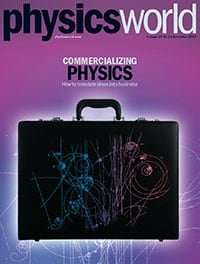[brightcove videoID=ref:phw.live/2014-10-31-issue-promo-november/1 playerID=106573614001 height=330 width=500]
By Matin Durrani
Some physicists can get a bit grumpy if talk turns to the supposedly dirty business of commercialization. They go into physics out of curiosity alone and have an innate dislike of ever having to justify their resarch in terms of potential spin-off benefits. But they can be thankful for the overall health and vitality of physics that some brave souls do risk their money and careers by setting up businesses to commercialize their findings.
The November 2014 issue of Physics World magazine gives a taste of some of the challenges in commercializing physics, as I describe with my colleague Margaret Harris in the video above. We kick off with one common problem for hi-tech start-ups, which is how to bridge the “valley of death” – in other words, what to do when your research funding has dried up but you’re not yet making any money from your product. Jesko von Windheim then examines why physics-based firms have a harder job than ordinary businesses, where succeeding is simply about finding a market and meeting its need, before we look back at some promising technologies tackled in Physics World’s Innovation column to see how they’ve fared. There are also some real-life lessons from Floor van de Pavert — a physicist who’s been at the business coal face — and we see how crowdfunding websites can help researchers get their ideas off the ground.
We’ve also been doing some innovation of your own and if you’re a member of the Institute of Physics (IOP), you can now enjoy immediate access to the new issue with the digital edition of the magazine on your desktop via MyIOP.org or on any iOS or Android smartphone or tablet via the Physics World app, available from the App Store and Google Play. If you’re not yet in the IOP, you can join as an IOPimember for just £15, €20 or $25 a year to get full access to Physics World both online and through the apps.

For the record, here’s a run-down of other highlights of the November issue.
• Blue LED research wins Nobel prize – Catch up with the 2014 prize to Isamu Akasaki, Hiroshi Amano and Shuji Nakamura for developing efficient blue light-emitting diodes.
• Lost in translation – Asking physicists to tailor their research to deliver specific “impacts” has the potential to distort the scientific method, warns Philip Moriarty.
• From hype to hope – Graphene promises a whole host of commercial applications, but Norman Apsley says that business and physics will have to work together to make it happen.
• Bell’s theorem still tolls – The famous proof of entanglement by John Bell is half
a century old. Robert P Crease recalls the strange story of its origin and history.
• Navigating the valley of death – Taking an innovation from the lab to the market is hard in any discipline, but physics start-ups face some unique challenges crossing the so-called “valley of death”. James Dacey speaks to scientists and business professionals in the Boston area of the US who have dared to take on this journey.
• More push than pull – Meeting the demands of the market is usually vital to any new business. But as Jesko von Windheim explains, tech-based firms have it much harder as there might not yet be a market pull for the technology they are trying to push.
• Whatever happened to..? – Each month, Physics World covers commercially relevant breakthroughs in its Innovation column. Tushna Commissariat and Louise Mayor checked in with the physicists behind some of the most interesting and promising innovations we have featured over the years, to find out how they fared.
• The rocky road to success – Doing science involves complex experiments with uncertain outcomes, and starting a company based on innovations from the lab is no different. Floor van de Pavert shares some of the lessons she learned from co-founding her first spin-off company.
• A little help from the crowd – Whether they need start-up capital to fund an innovation or some novel research, physicists the world over are turning to crowdfunding websites to support their next projects, as Jon Cartwright reports.
• A lucky, lonely planet – Duncan Forgan reviews Lucky Planet: Why Earth is Exceptional – and What That Means for Life in the Universe by David Waltham.
• 3000 years of questions – John Singleton reviews Faith and Wisdom in Science by Tom McLeish.
• The view from the VC side – With a PhD in theoretical physics and more than a decade of experience in the investment world, venture capitalist Alexei Andreev has seen his share of innovation successes and failures.
• Once a physicist – Meet Jennifer (Jenny) Rollo, a systems biologist ho studies Alzheimer’s disease at the University of Sydney, Australia.
• E-mail economics – In this month’s Lateral Thoughts column, Michael Hipkins wonders how to stem the deluge of e-mails we all receive each day.



